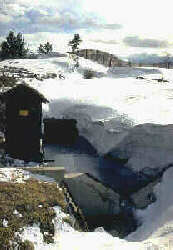Wind-blown Snow as a Water Resource
Research History
Research Methods - The Great Snow Ripoff
Wind swept almost all snowfall off the short-grass plain upwind of the Pole
Mountain snow fence. By measuring snowfall all winter with gages in the
surrounding forest, we estimated how much water the wind moved. The Snowman
built drift traps that measured how much escaped the fence (Jairell, 1975).
But when we added it all up, water in the snowdrift behind the fence was only
about half of what the wind took from the area upwind. The Smythe started
calculating the physics (Schmidt, 1972), and the BlizWiz started measuring the
humidity, and soon it was pretty clear that snow missing from the snowdrift had
evaporated as it blew toward the fence (Tabler and Schmidt, 1972).
More measurements confirmed our estimates of blizzard evaporation. Ron called
it "the great snow rip-off" (Tabler, 1975a). Based on snowfall, vegetation,
and wind speed, a conservative estimate of annual water loss in the state of
Wyoming, by evaporation of snow in blizzards, is 4 million acre feet. That
represents 25 percent of the state's average annual runoff.
We began to understand how much blowing snow evaporates, just about the time
I-80 west of Laramie, WY opened to traffic (1970).

 To Research Methods
To Research Methods


 To Research Methods
To Research Methods